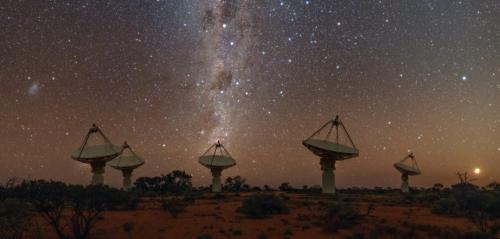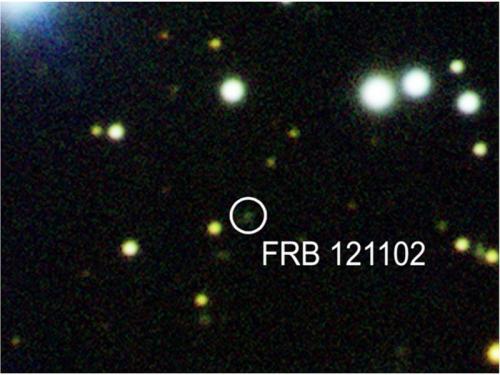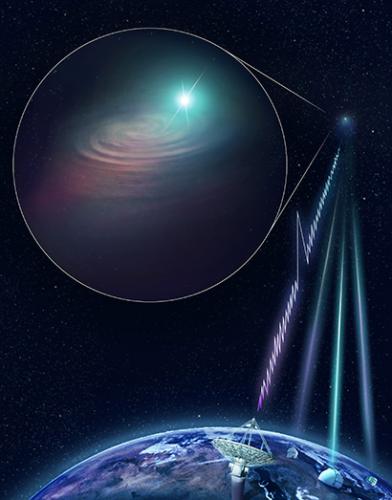Faint Repetitions of an Extragalactic Fast Radio Burst
New evidence deepens the mystery of fast radio bursts (FRBs), the brief flashes of radio emission stemming from unknown sources beyond our galaxy. Scientists have now discovered faint repeat bursts from one of the brightest FRBs, previously thought to have been a one-off event.

The Australian Square Kilometre Array Pathfinder (ASKAP) radio telescope is responsible for finding a number of fast radio bursts. But could there be fainter flashes that it’s missing?
To Repeat or Not to Repeat
It was over a decade ago that scientists noticed the first enigmatic, millisecond-duration burst of radio waves from outside of the Milky Way. Since then, we’ve discovered about 100 FRB sources and even identified the host galaxies for several of them. Nonetheless, we still don’t know what causes FRBs, or even whether they’re all the same type of phenomenon.

FRB 121102, the first fast radio burst found to repeat, was also the first to be localized in the sky.
FRB properties span a wide range, but one of the biggest distinguishing features has been repetition. While most discovered FRBs have been one-off events — a single bright flash and no evidence of any additional emission from the same region either before or after — around ten FRBs have been found to repeat.

Artist’s impression of the ASKAP radio telescope finding a fast radio burst. Other observatories are shown joining in follow-up observations.
We successfully localized one repeating FRB to a distant low-mass, low-metallicity dwarf galaxy. The two non-repeating bursts that we’ve localized, on the other hand, are associated with very massive host galaxies. Does this distinction mean that repeating and non-repeating bursts make up two different classes of FRBs? Or are FRBs all the same type of source, and the difference in host galaxies is just random variation?

Timeline of the ASKAP, Parkes, and Green Bank Telescope observations in the direction of FRB 171019. Red circles mark observed bursts.
Recently, a team of scientists led by Pravir Kumar (Swinburne University of Technology, Australia) has added one more clue to the puzzle: observations of weak repeat bursts from an FRB thought to be non-repeating.
What Are We Missing?
Kumar and collaborators were testing a simple theory: What if FRBs all repeat, but we don’t have the sensitivity to detect the fainter bursts?
In this scenario, supposed one-off FRBs are actually just the most energetic bursts from repeating sources. If we carefully study very sensitive observations of the region around a non-repeating burst, the team reasoned, we might find evidence of other bursts from the same source.
The authors chose FRB 171019 as their target — one of the brightest bursts found in a recent survey conducted with the Australian Square Kilometre Array Pathfinder (ASKAP). Kumar and collaborators used ASKAP itself, as well as the 64-meter Parkes radio telescope and the 110-meter Green Bank Telescope, to conduct follow-up observations of the 10’ x 10’ region FRB 171019 was determined to have originated from.
Faint Flashes Found
Though no additional bursts were found in the follow-up ASKAP or Parkes data, two faint bursts were visible in the 820 MHz Green Bank Telescope data, occurring 9 and 20 months after the initial ASKAP burst detection. The inferred distances are consistent with that of FRB 171019, but they are a whopping factor of ~590 fainter than the original burst!
This discovery lends credence to the idea that more seemingly one-off bright FRBs may actually have faint repetitions that we’ve simply missed — and these sources may be found to repeat if we conduct follow-up with more sensitive telescopes. Understanding this brings us one step closer to discovering the nature of these mysterious sources.
Source: American Astronomical Society
- 276 reads
Human Rights
Fostering a More Humane World: The 28th Eurasian Economic Summi

Conscience, Hope, and Action: Keys to Global Peace and Sustainability

Ringing FOWPAL’s Peace Bell for the World:Nobel Peace Prize Laureates’ Visions and Actions

Protecting the World’s Cultural Diversity for a Sustainable Future

Puppet Show I International Friendship Day 2020

